Major Assignment: Bill of Quantities for Quantity Surveying 200486
VerifiedAdded on 2023/06/12
|7
|1658
|228
Report
AI Summary
This document presents a comprehensive bill of quantity (BOQ) related to a building project, likely as part of a Quantity Surveying assignment. It includes an introduction to the importance of BOQs in construction projects, detailing how they are prepared by surveyors and architects, and then used by tenderers for pricing. The document also defines key design terms related to BOQs, such as item description, take-off list, and query sheet. A query sheet example is provided, showing questions from the surveyor to the structural engineer and their corresponding answers, covering topics like the role of a structural engineer, budget considerations, and material specifications. Furthermore, a take-off list is included, outlining various project activities and quantity aspects. Finally, a sample bill of quantity is presented, focusing on carpentry works, listing items, descriptions, dimensions, and quantities. This complete assignment is available on Desklib, along with numerous other resources for students.
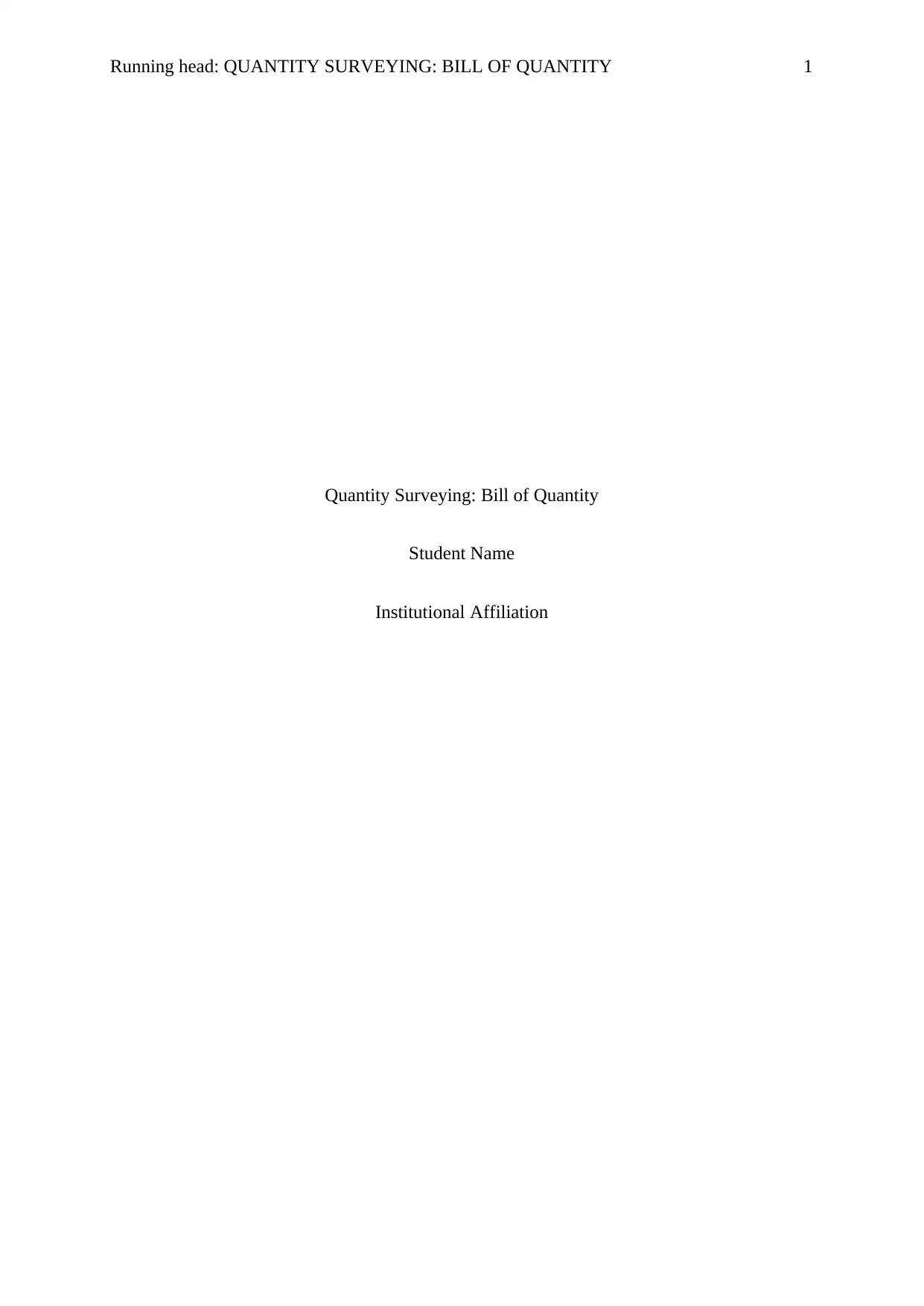
Running head: QUANTITY SURVEYING: BILL OF QUANTITY 1
Quantity Surveying: Bill of Quantity
Student Name
Institutional Affiliation
Quantity Surveying: Bill of Quantity
Student Name
Institutional Affiliation
Paraphrase This Document
Need a fresh take? Get an instant paraphrase of this document with our AI Paraphraser
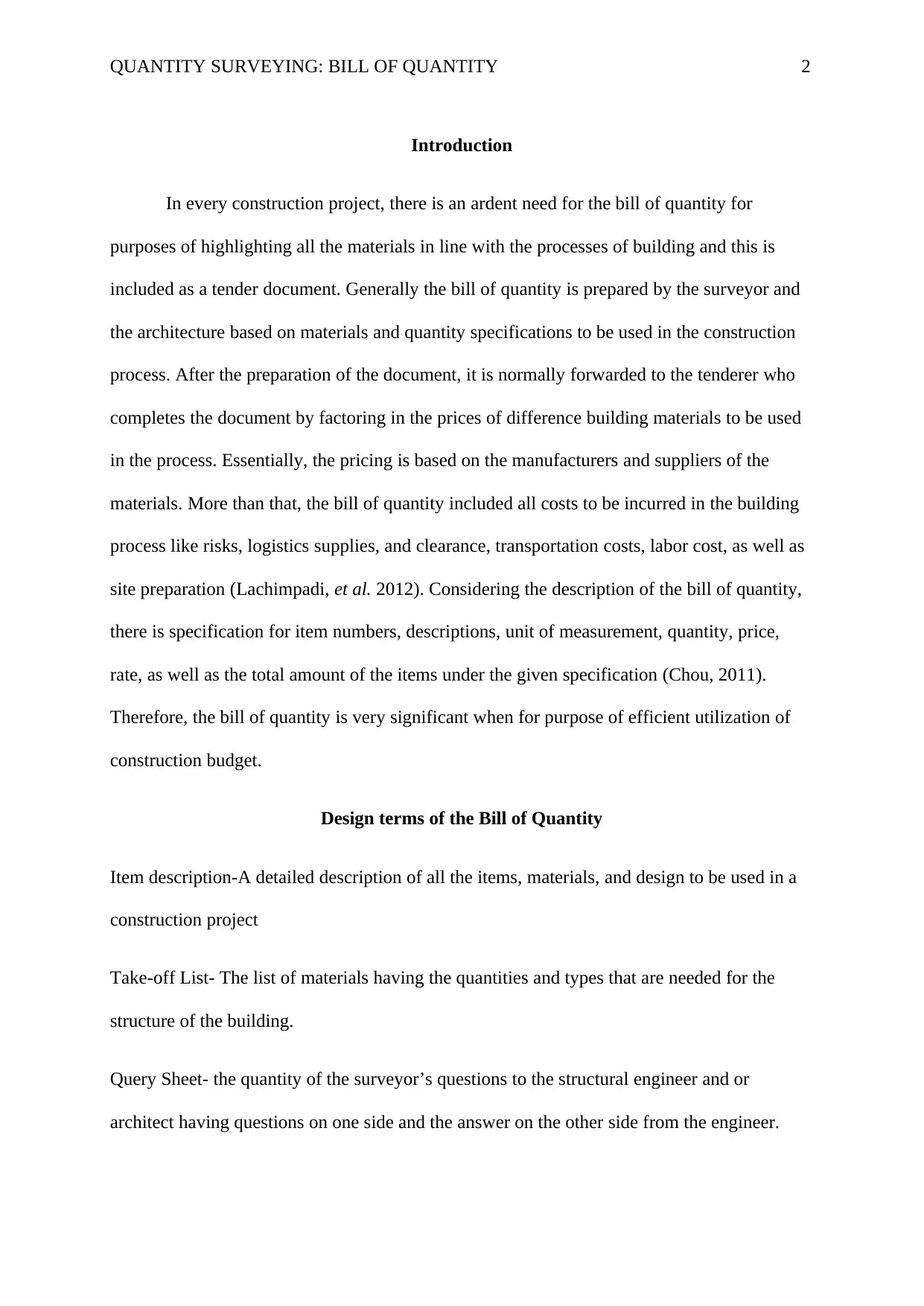
QUANTITY SURVEYING: BILL OF QUANTITY 2
Introduction
In every construction project, there is an ardent need for the bill of quantity for
purposes of highlighting all the materials in line with the processes of building and this is
included as a tender document. Generally the bill of quantity is prepared by the surveyor and
the architecture based on materials and quantity specifications to be used in the construction
process. After the preparation of the document, it is normally forwarded to the tenderer who
completes the document by factoring in the prices of difference building materials to be used
in the process. Essentially, the pricing is based on the manufacturers and suppliers of the
materials. More than that, the bill of quantity included all costs to be incurred in the building
process like risks, logistics supplies, and clearance, transportation costs, labor cost, as well as
site preparation (Lachimpadi, et al. 2012). Considering the description of the bill of quantity,
there is specification for item numbers, descriptions, unit of measurement, quantity, price,
rate, as well as the total amount of the items under the given specification (Chou, 2011).
Therefore, the bill of quantity is very significant when for purpose of efficient utilization of
construction budget.
Design terms of the Bill of Quantity
Item description-A detailed description of all the items, materials, and design to be used in a
construction project
Take-off List- The list of materials having the quantities and types that are needed for the
structure of the building.
Query Sheet- the quantity of the surveyor’s questions to the structural engineer and or
architect having questions on one side and the answer on the other side from the engineer.
Introduction
In every construction project, there is an ardent need for the bill of quantity for
purposes of highlighting all the materials in line with the processes of building and this is
included as a tender document. Generally the bill of quantity is prepared by the surveyor and
the architecture based on materials and quantity specifications to be used in the construction
process. After the preparation of the document, it is normally forwarded to the tenderer who
completes the document by factoring in the prices of difference building materials to be used
in the process. Essentially, the pricing is based on the manufacturers and suppliers of the
materials. More than that, the bill of quantity included all costs to be incurred in the building
process like risks, logistics supplies, and clearance, transportation costs, labor cost, as well as
site preparation (Lachimpadi, et al. 2012). Considering the description of the bill of quantity,
there is specification for item numbers, descriptions, unit of measurement, quantity, price,
rate, as well as the total amount of the items under the given specification (Chou, 2011).
Therefore, the bill of quantity is very significant when for purpose of efficient utilization of
construction budget.
Design terms of the Bill of Quantity
Item description-A detailed description of all the items, materials, and design to be used in a
construction project
Take-off List- The list of materials having the quantities and types that are needed for the
structure of the building.
Query Sheet- the quantity of the surveyor’s questions to the structural engineer and or
architect having questions on one side and the answer on the other side from the engineer.
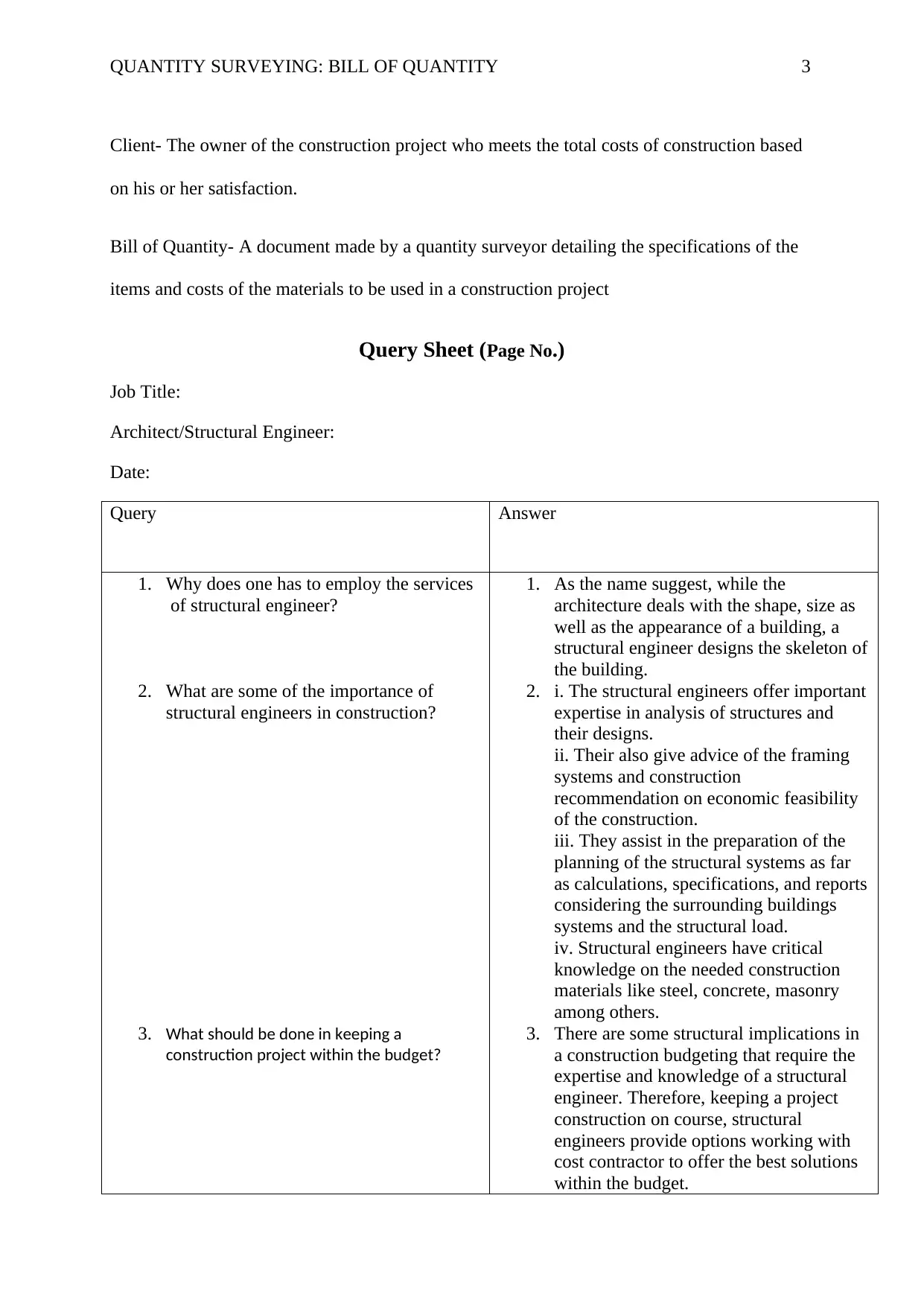
QUANTITY SURVEYING: BILL OF QUANTITY 3
Client- The owner of the construction project who meets the total costs of construction based
on his or her satisfaction.
Bill of Quantity- A document made by a quantity surveyor detailing the specifications of the
items and costs of the materials to be used in a construction project
Query Sheet (Page No.)
Job Title:
Architect/Structural Engineer:
Date:
Query Answer
1. Why does one has to employ the services
of structural engineer?
2. What are some of the importance of
structural engineers in construction?
3. What should be done in keeping a
construction project within the budget?
1. As the name suggest, while the
architecture deals with the shape, size as
well as the appearance of a building, a
structural engineer designs the skeleton of
the building.
2. i. The structural engineers offer important
expertise in analysis of structures and
their designs.
ii. Their also give advice of the framing
systems and construction
recommendation on economic feasibility
of the construction.
iii. They assist in the preparation of the
planning of the structural systems as far
as calculations, specifications, and reports
considering the surrounding buildings
systems and the structural load.
iv. Structural engineers have critical
knowledge on the needed construction
materials like steel, concrete, masonry
among others.
3. There are some structural implications in
a construction budgeting that require the
expertise and knowledge of a structural
engineer. Therefore, keeping a project
construction on course, structural
engineers provide options working with
cost contractor to offer the best solutions
within the budget.
Client- The owner of the construction project who meets the total costs of construction based
on his or her satisfaction.
Bill of Quantity- A document made by a quantity surveyor detailing the specifications of the
items and costs of the materials to be used in a construction project
Query Sheet (Page No.)
Job Title:
Architect/Structural Engineer:
Date:
Query Answer
1. Why does one has to employ the services
of structural engineer?
2. What are some of the importance of
structural engineers in construction?
3. What should be done in keeping a
construction project within the budget?
1. As the name suggest, while the
architecture deals with the shape, size as
well as the appearance of a building, a
structural engineer designs the skeleton of
the building.
2. i. The structural engineers offer important
expertise in analysis of structures and
their designs.
ii. Their also give advice of the framing
systems and construction
recommendation on economic feasibility
of the construction.
iii. They assist in the preparation of the
planning of the structural systems as far
as calculations, specifications, and reports
considering the surrounding buildings
systems and the structural load.
iv. Structural engineers have critical
knowledge on the needed construction
materials like steel, concrete, masonry
among others.
3. There are some structural implications in
a construction budgeting that require the
expertise and knowledge of a structural
engineer. Therefore, keeping a project
construction on course, structural
engineers provide options working with
cost contractor to offer the best solutions
within the budget.
⊘ This is a preview!⊘
Do you want full access?
Subscribe today to unlock all pages.

Trusted by 1+ million students worldwide
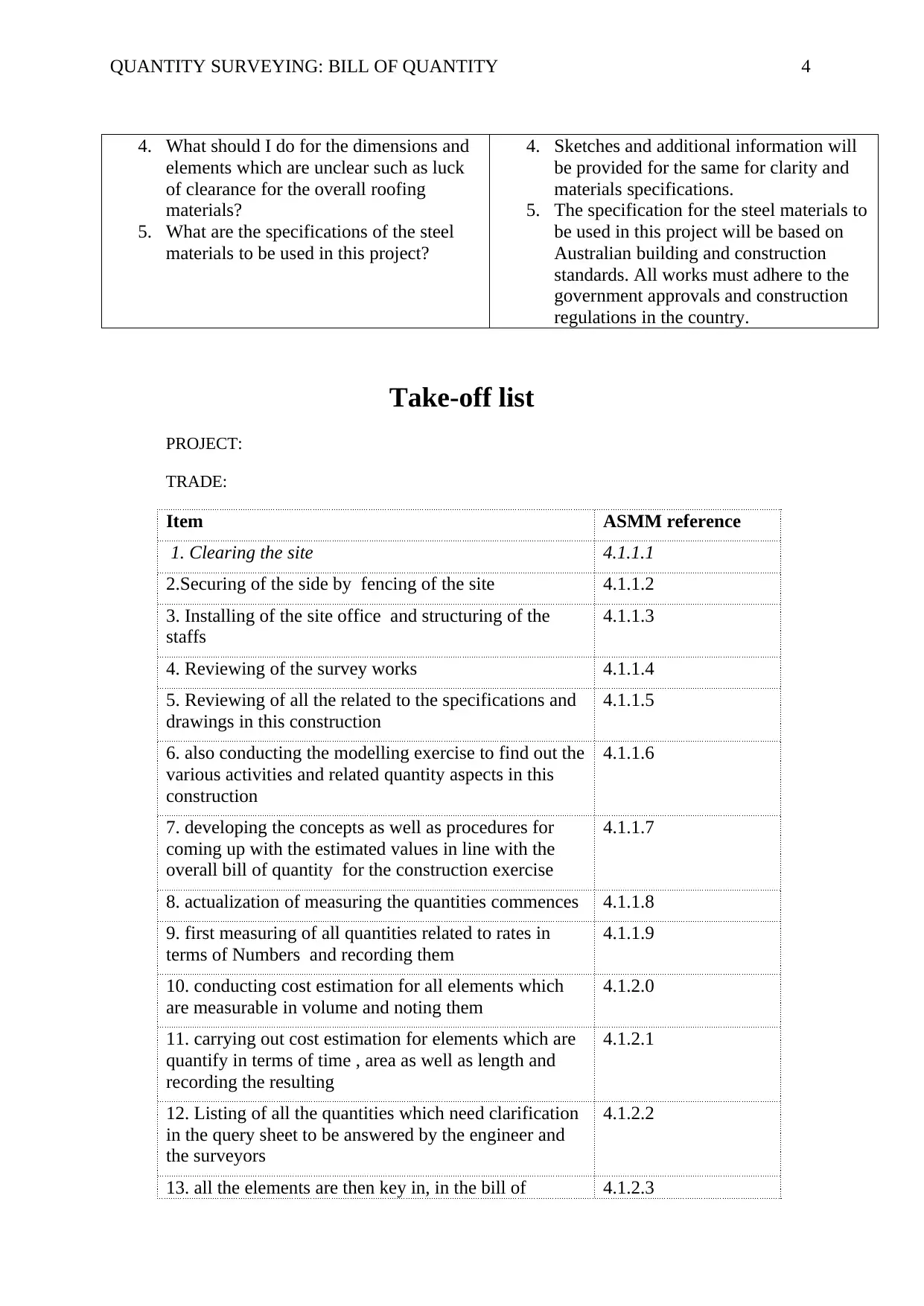
QUANTITY SURVEYING: BILL OF QUANTITY 4
4. What should I do for the dimensions and
elements which are unclear such as luck
of clearance for the overall roofing
materials?
5. What are the specifications of the steel
materials to be used in this project?
4. Sketches and additional information will
be provided for the same for clarity and
materials specifications.
5. The specification for the steel materials to
be used in this project will be based on
Australian building and construction
standards. All works must adhere to the
government approvals and construction
regulations in the country.
Take-off list
PROJECT:
TRADE:
Item ASMM reference
1. Clearing the site 4.1.1.1
2.Securing of the side by fencing of the site 4.1.1.2
3. Installing of the site office and structuring of the
staffs
4.1.1.3
4. Reviewing of the survey works 4.1.1.4
5. Reviewing of all the related to the specifications and
drawings in this construction
4.1.1.5
6. also conducting the modelling exercise to find out the
various activities and related quantity aspects in this
construction
4.1.1.6
7. developing the concepts as well as procedures for
coming up with the estimated values in line with the
overall bill of quantity for the construction exercise
4.1.1.7
8. actualization of measuring the quantities commences 4.1.1.8
9. first measuring of all quantities related to rates in
terms of Numbers and recording them
4.1.1.9
10. conducting cost estimation for all elements which
are measurable in volume and noting them
4.1.2.0
11. carrying out cost estimation for elements which are
quantify in terms of time , area as well as length and
recording the resulting
4.1.2.1
12. Listing of all the quantities which need clarification
in the query sheet to be answered by the engineer and
the surveyors
4.1.2.2
13. all the elements are then key in, in the bill of 4.1.2.3
4. What should I do for the dimensions and
elements which are unclear such as luck
of clearance for the overall roofing
materials?
5. What are the specifications of the steel
materials to be used in this project?
4. Sketches and additional information will
be provided for the same for clarity and
materials specifications.
5. The specification for the steel materials to
be used in this project will be based on
Australian building and construction
standards. All works must adhere to the
government approvals and construction
regulations in the country.
Take-off list
PROJECT:
TRADE:
Item ASMM reference
1. Clearing the site 4.1.1.1
2.Securing of the side by fencing of the site 4.1.1.2
3. Installing of the site office and structuring of the
staffs
4.1.1.3
4. Reviewing of the survey works 4.1.1.4
5. Reviewing of all the related to the specifications and
drawings in this construction
4.1.1.5
6. also conducting the modelling exercise to find out the
various activities and related quantity aspects in this
construction
4.1.1.6
7. developing the concepts as well as procedures for
coming up with the estimated values in line with the
overall bill of quantity for the construction exercise
4.1.1.7
8. actualization of measuring the quantities commences 4.1.1.8
9. first measuring of all quantities related to rates in
terms of Numbers and recording them
4.1.1.9
10. conducting cost estimation for all elements which
are measurable in volume and noting them
4.1.2.0
11. carrying out cost estimation for elements which are
quantify in terms of time , area as well as length and
recording the resulting
4.1.2.1
12. Listing of all the quantities which need clarification
in the query sheet to be answered by the engineer and
the surveyors
4.1.2.2
13. all the elements are then key in, in the bill of 4.1.2.3
Paraphrase This Document
Need a fresh take? Get an instant paraphrase of this document with our AI Paraphraser
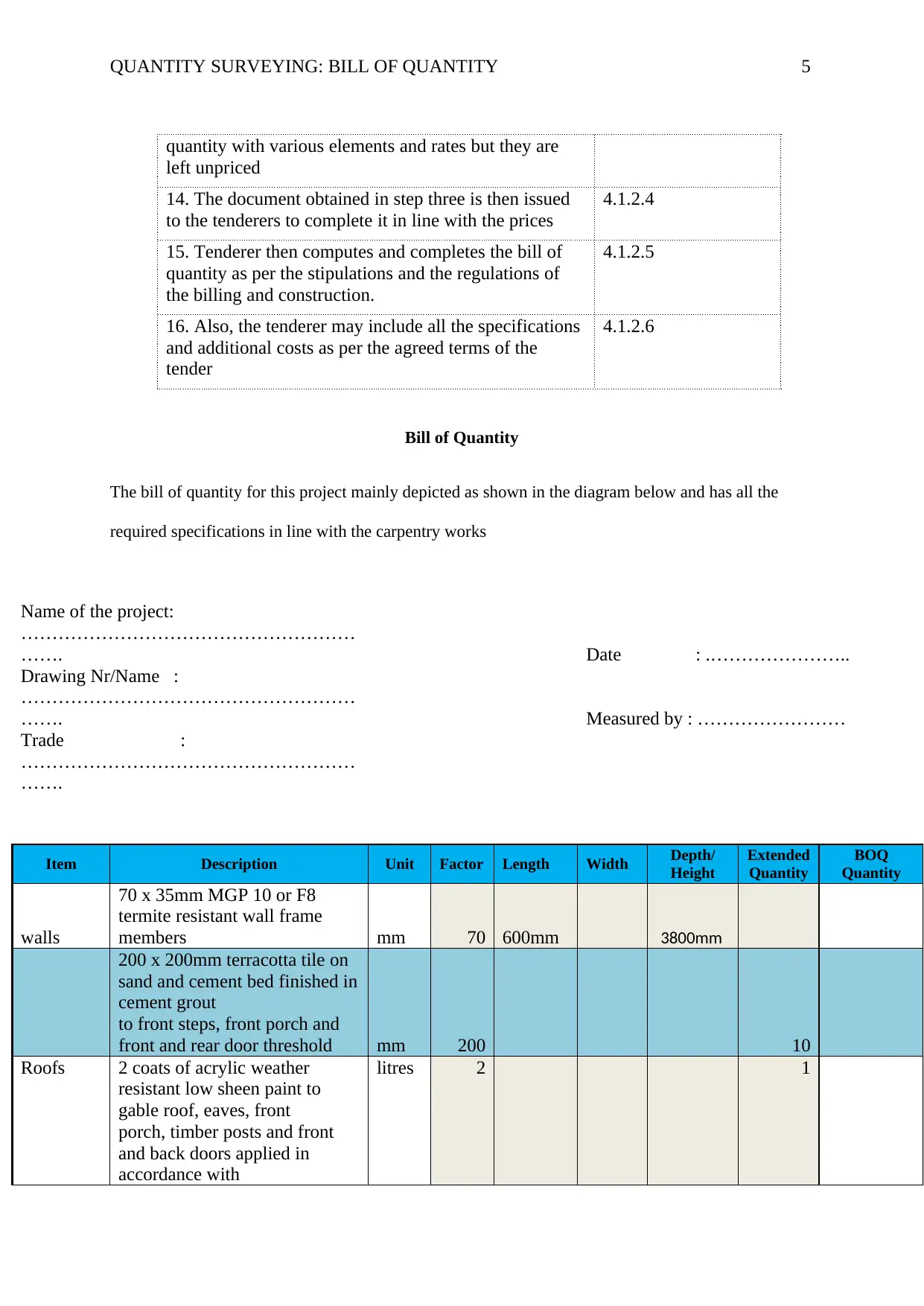
QUANTITY SURVEYING: BILL OF QUANTITY 5
quantity with various elements and rates but they are
left unpriced
14. The document obtained in step three is then issued
to the tenderers to complete it in line with the prices
4.1.2.4
15. Tenderer then computes and completes the bill of
quantity as per the stipulations and the regulations of
the billing and construction.
4.1.2.5
16. Also, the tenderer may include all the specifications
and additional costs as per the agreed terms of the
tender
4.1.2.6
Bill of Quantity
The bill of quantity for this project mainly depicted as shown in the diagram below and has all the
required specifications in line with the carpentry works
Name of the project:
………………………………………………
……. Date : .…………………..
Drawing Nr/Name :
………………………………………………
……. Measured by : ……………………
Trade :
………………………………………………
…….
Item Description Unit Factor Length Width Depth/
Height
Extended
Quantity
BOQ
Quantity
walls
70 x 35mm MGP 10 or F8
termite resistant wall frame
members mm 70 600mm 3800mm
200 x 200mm terracotta tile on
sand and cement bed finished in
cement grout
to front steps, front porch and
front and rear door threshold mm 200 10
Roofs 2 coats of acrylic weather
resistant low sheen paint to
gable roof, eaves, front
porch, timber posts and front
and back doors applied in
accordance with
litres 2 1
quantity with various elements and rates but they are
left unpriced
14. The document obtained in step three is then issued
to the tenderers to complete it in line with the prices
4.1.2.4
15. Tenderer then computes and completes the bill of
quantity as per the stipulations and the regulations of
the billing and construction.
4.1.2.5
16. Also, the tenderer may include all the specifications
and additional costs as per the agreed terms of the
tender
4.1.2.6
Bill of Quantity
The bill of quantity for this project mainly depicted as shown in the diagram below and has all the
required specifications in line with the carpentry works
Name of the project:
………………………………………………
……. Date : .…………………..
Drawing Nr/Name :
………………………………………………
……. Measured by : ……………………
Trade :
………………………………………………
…….
Item Description Unit Factor Length Width Depth/
Height
Extended
Quantity
BOQ
Quantity
walls
70 x 35mm MGP 10 or F8
termite resistant wall frame
members mm 70 600mm 3800mm
200 x 200mm terracotta tile on
sand and cement bed finished in
cement grout
to front steps, front porch and
front and rear door threshold mm 200 10
Roofs 2 coats of acrylic weather
resistant low sheen paint to
gable roof, eaves, front
porch, timber posts and front
and back doors applied in
accordance with
litres 2 1
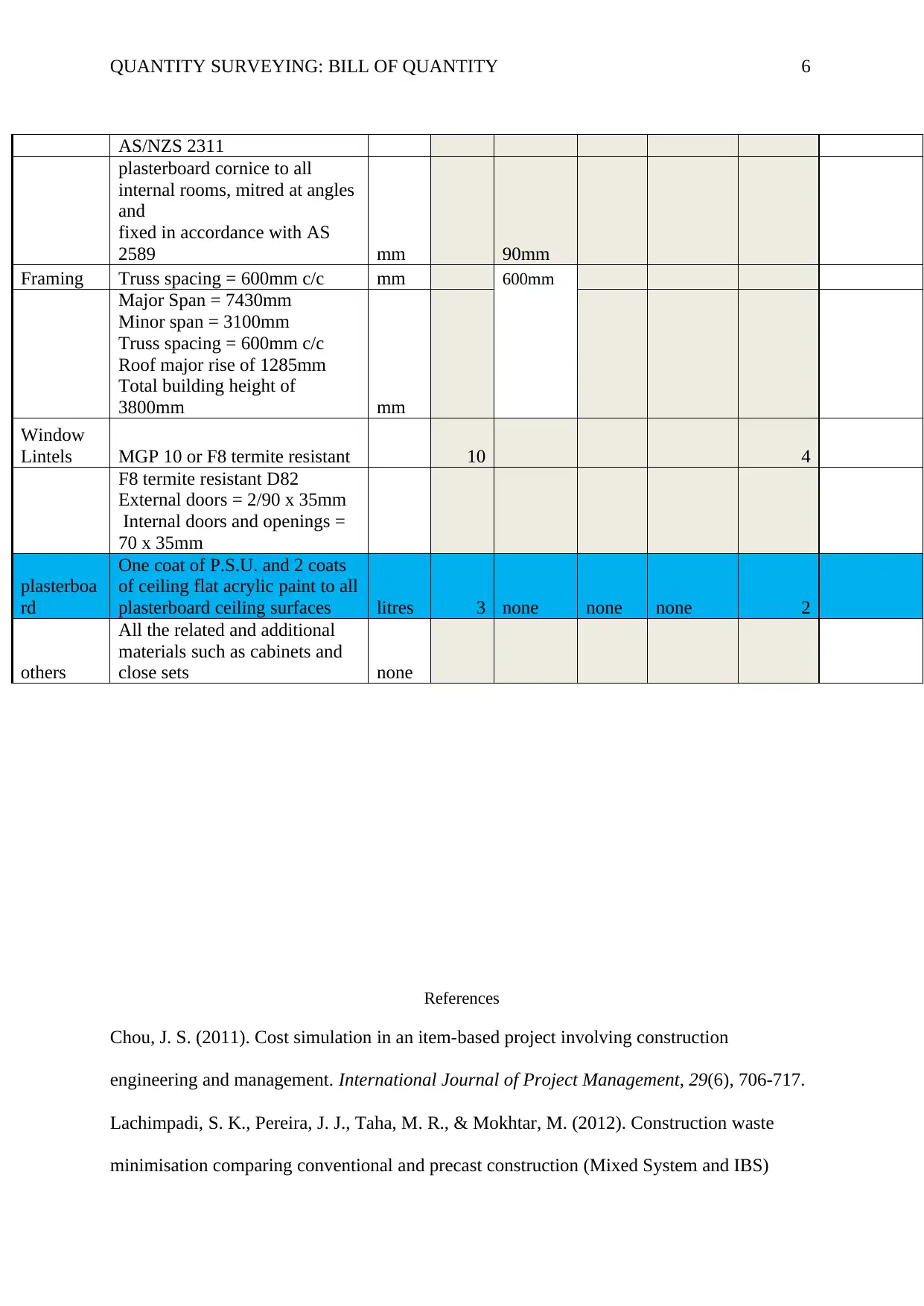
QUANTITY SURVEYING: BILL OF QUANTITY 6
AS/NZS 2311
plasterboard cornice to all
internal rooms, mitred at angles
and
fixed in accordance with AS
2589 mm 90mm
Framing Truss spacing = 600mm c/c mm 600mm
Major Span = 7430mm
Minor span = 3100mm
Truss spacing = 600mm c/c
Roof major rise of 1285mm
Total building height of
3800mm mm
Window
Lintels MGP 10 or F8 termite resistant 10 4
F8 termite resistant D82
External doors = 2/90 x 35mm
Internal doors and openings =
70 x 35mm
plasterboa
rd
One coat of P.S.U. and 2 coats
of ceiling flat acrylic paint to all
plasterboard ceiling surfaces litres 3 none none none 2
others
All the related and additional
materials such as cabinets and
close sets none
References
Chou, J. S. (2011). Cost simulation in an item-based project involving construction
engineering and management. International Journal of Project Management, 29(6), 706-717.
Lachimpadi, S. K., Pereira, J. J., Taha, M. R., & Mokhtar, M. (2012). Construction waste
minimisation comparing conventional and precast construction (Mixed System and IBS)
AS/NZS 2311
plasterboard cornice to all
internal rooms, mitred at angles
and
fixed in accordance with AS
2589 mm 90mm
Framing Truss spacing = 600mm c/c mm 600mm
Major Span = 7430mm
Minor span = 3100mm
Truss spacing = 600mm c/c
Roof major rise of 1285mm
Total building height of
3800mm mm
Window
Lintels MGP 10 or F8 termite resistant 10 4
F8 termite resistant D82
External doors = 2/90 x 35mm
Internal doors and openings =
70 x 35mm
plasterboa
rd
One coat of P.S.U. and 2 coats
of ceiling flat acrylic paint to all
plasterboard ceiling surfaces litres 3 none none none 2
others
All the related and additional
materials such as cabinets and
close sets none
References
Chou, J. S. (2011). Cost simulation in an item-based project involving construction
engineering and management. International Journal of Project Management, 29(6), 706-717.
Lachimpadi, S. K., Pereira, J. J., Taha, M. R., & Mokhtar, M. (2012). Construction waste
minimisation comparing conventional and precast construction (Mixed System and IBS)
⊘ This is a preview!⊘
Do you want full access?
Subscribe today to unlock all pages.

Trusted by 1+ million students worldwide
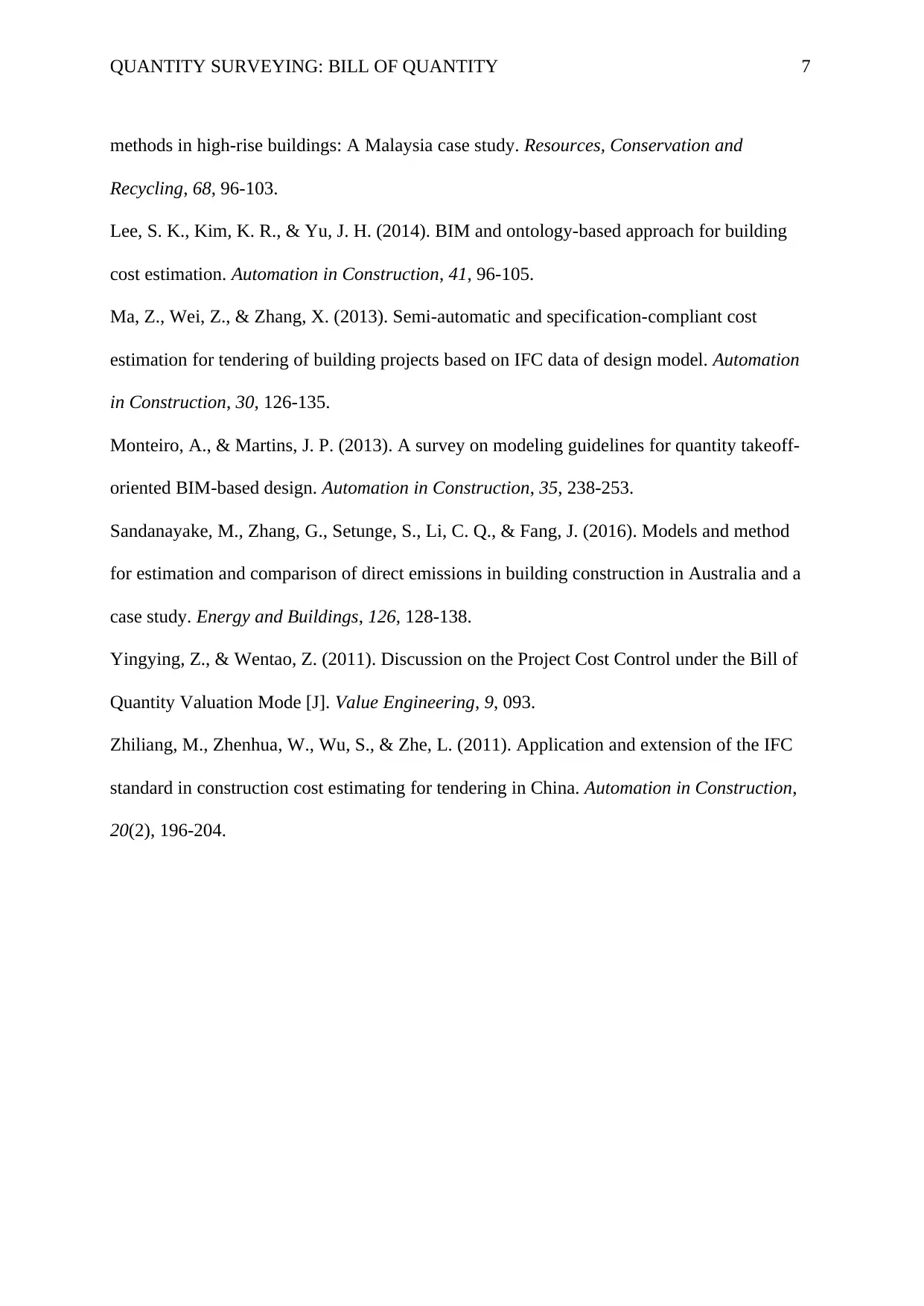
QUANTITY SURVEYING: BILL OF QUANTITY 7
methods in high-rise buildings: A Malaysia case study. Resources, Conservation and
Recycling, 68, 96-103.
Lee, S. K., Kim, K. R., & Yu, J. H. (2014). BIM and ontology-based approach for building
cost estimation. Automation in Construction, 41, 96-105.
Ma, Z., Wei, Z., & Zhang, X. (2013). Semi-automatic and specification-compliant cost
estimation for tendering of building projects based on IFC data of design model. Automation
in Construction, 30, 126-135.
Monteiro, A., & Martins, J. P. (2013). A survey on modeling guidelines for quantity takeoff-
oriented BIM-based design. Automation in Construction, 35, 238-253.
Sandanayake, M., Zhang, G., Setunge, S., Li, C. Q., & Fang, J. (2016). Models and method
for estimation and comparison of direct emissions in building construction in Australia and a
case study. Energy and Buildings, 126, 128-138.
Yingying, Z., & Wentao, Z. (2011). Discussion on the Project Cost Control under the Bill of
Quantity Valuation Mode [J]. Value Engineering, 9, 093.
Zhiliang, M., Zhenhua, W., Wu, S., & Zhe, L. (2011). Application and extension of the IFC
standard in construction cost estimating for tendering in China. Automation in Construction,
20(2), 196-204.
methods in high-rise buildings: A Malaysia case study. Resources, Conservation and
Recycling, 68, 96-103.
Lee, S. K., Kim, K. R., & Yu, J. H. (2014). BIM and ontology-based approach for building
cost estimation. Automation in Construction, 41, 96-105.
Ma, Z., Wei, Z., & Zhang, X. (2013). Semi-automatic and specification-compliant cost
estimation for tendering of building projects based on IFC data of design model. Automation
in Construction, 30, 126-135.
Monteiro, A., & Martins, J. P. (2013). A survey on modeling guidelines for quantity takeoff-
oriented BIM-based design. Automation in Construction, 35, 238-253.
Sandanayake, M., Zhang, G., Setunge, S., Li, C. Q., & Fang, J. (2016). Models and method
for estimation and comparison of direct emissions in building construction in Australia and a
case study. Energy and Buildings, 126, 128-138.
Yingying, Z., & Wentao, Z. (2011). Discussion on the Project Cost Control under the Bill of
Quantity Valuation Mode [J]. Value Engineering, 9, 093.
Zhiliang, M., Zhenhua, W., Wu, S., & Zhe, L. (2011). Application and extension of the IFC
standard in construction cost estimating for tendering in China. Automation in Construction,
20(2), 196-204.
1 out of 7
Related Documents
Your All-in-One AI-Powered Toolkit for Academic Success.
+13062052269
info@desklib.com
Available 24*7 on WhatsApp / Email
![[object Object]](/_next/static/media/star-bottom.7253800d.svg)
Unlock your academic potential
Copyright © 2020–2025 A2Z Services. All Rights Reserved. Developed and managed by ZUCOL.





